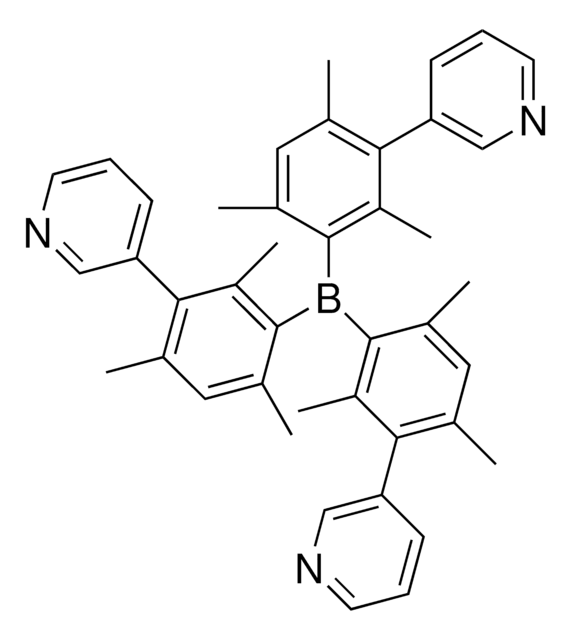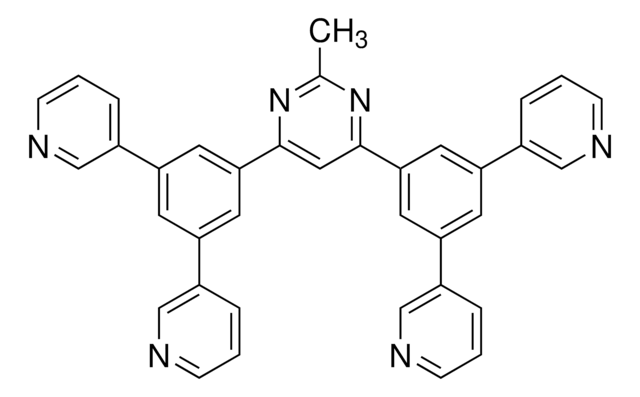699152
Bathocuproine
sublimed grade, 99.99% trace metals basis
Synonym(s):
2,9-Dimethyl-4,7-diphenyl-1,10-phenanthroline, BCP
About This Item
Recommended Products
grade
sublimed grade
Assay
99.99% trace metals basis
form
powder
greener alternative product characteristics
Design for Energy Efficiency
Learn more about the Principles of Green Chemistry.
sustainability
Greener Alternative Product
mp
279-283 °C (lit.)
285 °C (DSC)
λmax
277 nm
fluorescence
λem 386 nm in THF
Orbital energy
HOMO 7 eV
LUMO 3.5 eV
OLED Device Performance
ITO/CuPc/NPD/TCTA/mCP:Firpic (6%)/BCP/LiF/Al
ITO/NPD/CBP:Ir(ppy)3/BCP/Alq3/Mg:Al
ITO/NPD/TCTA/BCPO:Ir(piq)3 (7-8%)/BCP/Alq3/LiF/Al
ITO/NPD/TCTA/BCPO:Ir(ppy)3 (7-8%)/BCP/Alq3/LiF/Al
greener alternative category
, Enabling
SMILES string
Cc1cc(-c2ccccc2)c3ccc4c(cc(C)nc4c3n1)-c5ccccc5
InChI
1S/C26H20N2/c1-17-15-23(19-9-5-3-6-10-19)21-13-14-22-24(20-11-7-4-8-12-20)16-18(2)28-26(22)25(21)27-17/h3-16H,1-2H3
InChI key
STTGYIUESPWXOW-UHFFFAOYSA-N
Looking for similar products? Visit Product Comparison Guide
General description
Application
Signal Word
Warning
Hazard Statements
Precautionary Statements
Hazard Classifications
Acute Tox. 4 Oral - Aquatic Chronic 4
Storage Class Code
11 - Combustible Solids
WGK
WGK 3
Flash Point(F)
Not applicable
Flash Point(C)
Not applicable
Personal Protective Equipment
Certificates of Analysis (COA)
Search for Certificates of Analysis (COA) by entering the products Lot/Batch Number. Lot and Batch Numbers can be found on a product’s label following the words ‘Lot’ or ‘Batch’.
Already Own This Product?
Find documentation for the products that you have recently purchased in the Document Library.
Customers Also Viewed
Articles
Silylethyne substitution offers an opportunity to tune solubility for application-specific needs and self-assembly for electronic performance and has yielded semiconductors with excellent device performance.
Silylethyne substitution offers an opportunity to tune solubility for application-specific needs and self-assembly for electronic performance and has yielded semiconductors with excellent device performance.
Silylethyne substitution offers an opportunity to tune solubility for application-specific needs and self-assembly for electronic performance and has yielded semiconductors with excellent device performance.
Silylethyne substitution offers an opportunity to tune solubility for application-specific needs and self-assembly for electronic performance and has yielded semiconductors with excellent device performance.
Our team of scientists has experience in all areas of research including Life Science, Material Science, Chemical Synthesis, Chromatography, Analytical and many others.
Contact Technical Service



![[6,6]-Phenyl C61 butyric acid methyl ester >99.5%](/deepweb/assets/sigmaaldrich/product/structures/359/221/d990c746-0960-4c69-bf76-fe09b193824d/640/d990c746-0960-4c69-bf76-fe09b193824d.png)








